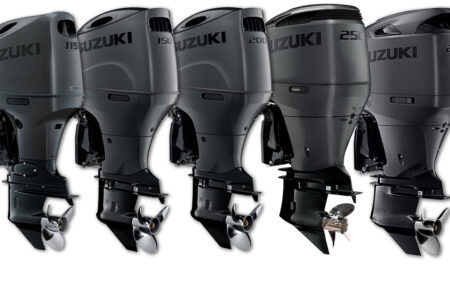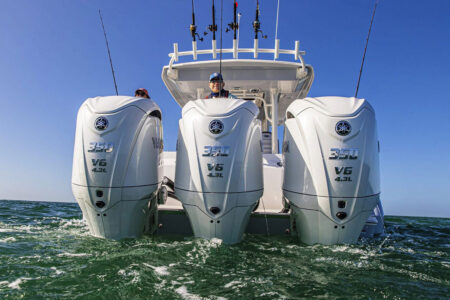2020 was a year that many of us want to forget for myriad reasons, and it also claimed two big names in the world of outboard motors. Seven Marine, a collection of visionary ex-Mercury engineers that had a bigger and better idea and created a niche market to manufacture high-horsepower hybrid outboard engines seen on some of today’s big ticket 55-to-65 foot center console and express sportfishers, has ceased production as of November 2020. Seven Marine was purchased by Volvo a few years back to enable this inboard/IO builder to have a turnkey “big boat” outboard solution, complemented by a nationwide service network, which seemed like an excellent marriage at the time. This move was counter-punched a few months later by both Yamaha with their popular 425 XTO Offshore V8 and Mercury with their 400 Verado and 450R V8 four-strokes, all of which were lighter and readily available via nationwide dealer networks. They were also priced at less than half the cost of the Seven Marine powerplants. Volvo pulled the plug on this operation after a short market exposure to “concentrate on their core businesses.”
The Covid-19 pandemic also claimed the life of BRP’s Evinrude outboards, the last maker of two-stroke powerplants. The official press release is detailed in the Evinrude section. As far back as 2006, when the second generation of four-stroke outboards was showing us that they were getting lighter, faster and stronger, I had hinted at the eventual extinction of the two-stroke outboard in this annual review. I put my own money where my opinions were and have been using four-stroke outboards on all of my boats since 2004. Ole Evinrude developed a great concept with the original two stroke outboard, to be joined by competitor Carl Keikhaefer of Mercury Marine, but in the final analysis, Mercury moved on to four-stroke technology and Evinrude chose to stick with two-strokes to the end. It’s now time to officially turn the page on the venerable two-strokes, which offered some real world benefits, but also had their limitations. Even though the majority of the outboard manufacturers that are left are relatively quiet for 2021, there are still a few new engines that have been introduced into the marine marketplace.
Suzuki
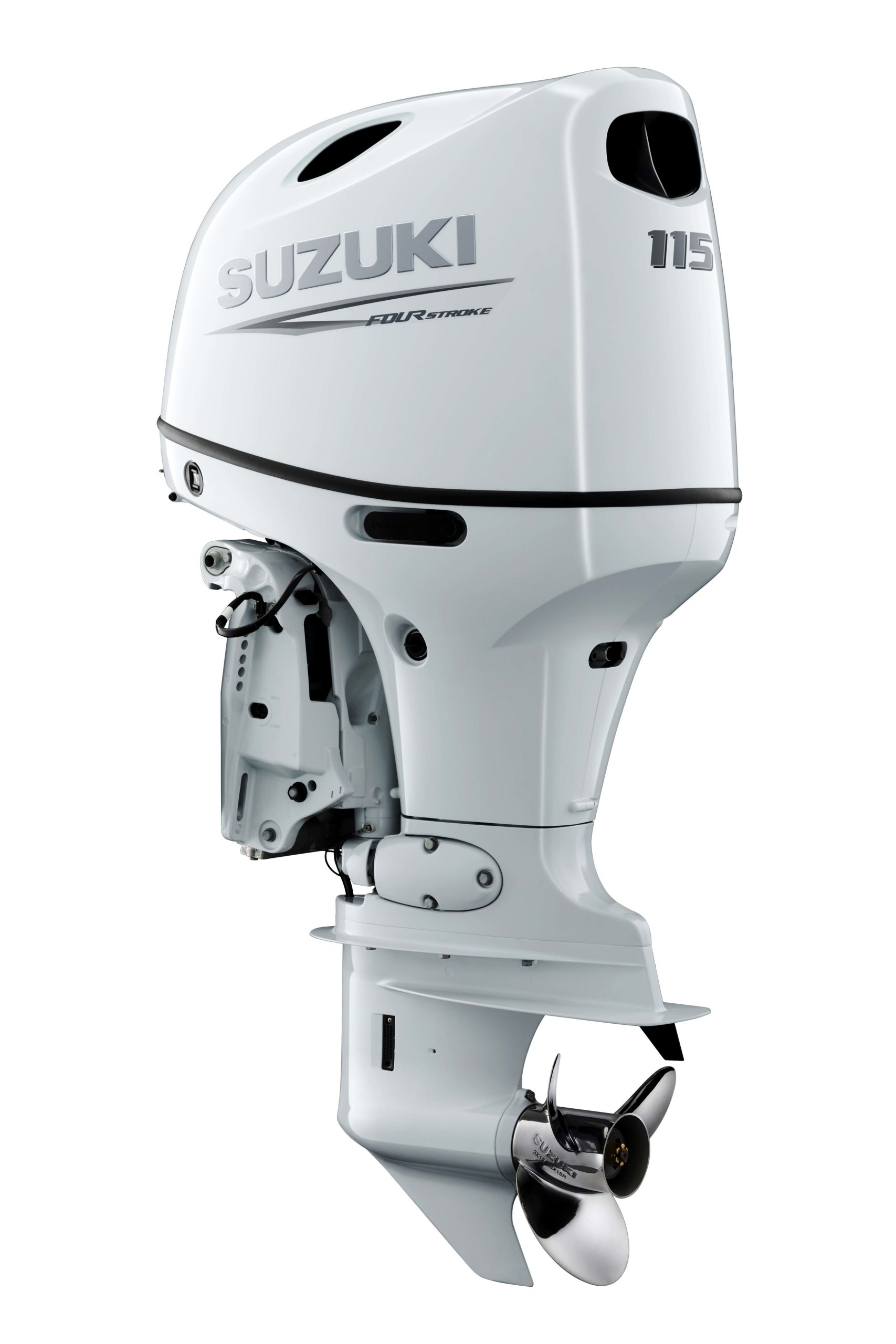 Suzuki’s new DF115BG and DF140BG four strokes are going to shake up the mid-sized class of competitive outboards, offering new features not found before in this power bandwidth. Last season, Suzuki did a “reset” of its older DF115 and DF140 outboards, upgrading them to the DF115A and DF140A models, both of which share a larger 2.0 liter powerhead. According to my recent conversations with the Suzuki PR team, these new “BG” series four-strokes continue the evolutionary path to newer, better and bigger things, all while staying within the same lightweight footprint. These newbies are the first in their class to offer all the advantages of drive-by-wire technology. By bringing its proven drive-by-wire technology to its 115HP and 140HP in-line four-cylinder models, Suzuki is providing simplified rigging for a wide range of boat builders, along with silky smooth shifting, instant throttle response, enhanced performance and superior fuel efficiency. An upgraded compression ratio of 10.6:1 helps these new 2.0-liter displacement outboards achieve better top speed and acceleration by improving thermal efficiency. Fuel is delivered via a throttle body digital EFI system and fuel efficiency has been increased as compared to Suzuki’s existing DF115/DF140A models. Factory tests have demonstrated five to seven percent better fuel efficiency for these new engines at cruising speed. Other improvements include a 40-amp alternator on both models that delivers improved output and battery charging performance at low idle speeds, which is ideal for today’s power-hungry fishing boats that spend a lot of time trolling. The engines’ exterior features a sporty, streamlined exterior design and are available in both 20-inch (L) and 25-inch (X) shaft lengths. Both new outboards boast new graphics and are available in Suzuki’s Pearl Nebular Black and Cool White color schemes. The redesigned cowl also incorporates a new air intake structure with improved water separation and a silencer/resonator system to attenuate engine noise and provide a pleasant boating experience at all engine speeds/RPM. To make routine maintenance easier, Suzuki made it possible to replace the oil filter simply by removing the upper engine cover. A new Oil Spill Catcher surrounding the oil filter mount allows for changing the filter without making a mess. Suzuki also added an easy access Water Detection Fuel Filter to help protect the engine against contaminated fuel. For more information, visit www.suzukimarine.com.
Suzuki’s new DF115BG and DF140BG four strokes are going to shake up the mid-sized class of competitive outboards, offering new features not found before in this power bandwidth. Last season, Suzuki did a “reset” of its older DF115 and DF140 outboards, upgrading them to the DF115A and DF140A models, both of which share a larger 2.0 liter powerhead. According to my recent conversations with the Suzuki PR team, these new “BG” series four-strokes continue the evolutionary path to newer, better and bigger things, all while staying within the same lightweight footprint. These newbies are the first in their class to offer all the advantages of drive-by-wire technology. By bringing its proven drive-by-wire technology to its 115HP and 140HP in-line four-cylinder models, Suzuki is providing simplified rigging for a wide range of boat builders, along with silky smooth shifting, instant throttle response, enhanced performance and superior fuel efficiency. An upgraded compression ratio of 10.6:1 helps these new 2.0-liter displacement outboards achieve better top speed and acceleration by improving thermal efficiency. Fuel is delivered via a throttle body digital EFI system and fuel efficiency has been increased as compared to Suzuki’s existing DF115/DF140A models. Factory tests have demonstrated five to seven percent better fuel efficiency for these new engines at cruising speed. Other improvements include a 40-amp alternator on both models that delivers improved output and battery charging performance at low idle speeds, which is ideal for today’s power-hungry fishing boats that spend a lot of time trolling. The engines’ exterior features a sporty, streamlined exterior design and are available in both 20-inch (L) and 25-inch (X) shaft lengths. Both new outboards boast new graphics and are available in Suzuki’s Pearl Nebular Black and Cool White color schemes. The redesigned cowl also incorporates a new air intake structure with improved water separation and a silencer/resonator system to attenuate engine noise and provide a pleasant boating experience at all engine speeds/RPM. To make routine maintenance easier, Suzuki made it possible to replace the oil filter simply by removing the upper engine cover. A new Oil Spill Catcher surrounding the oil filter mount allows for changing the filter without making a mess. Suzuki also added an easy access Water Detection Fuel Filter to help protect the engine against contaminated fuel. For more information, visit www.suzukimarine.com.
Mercury
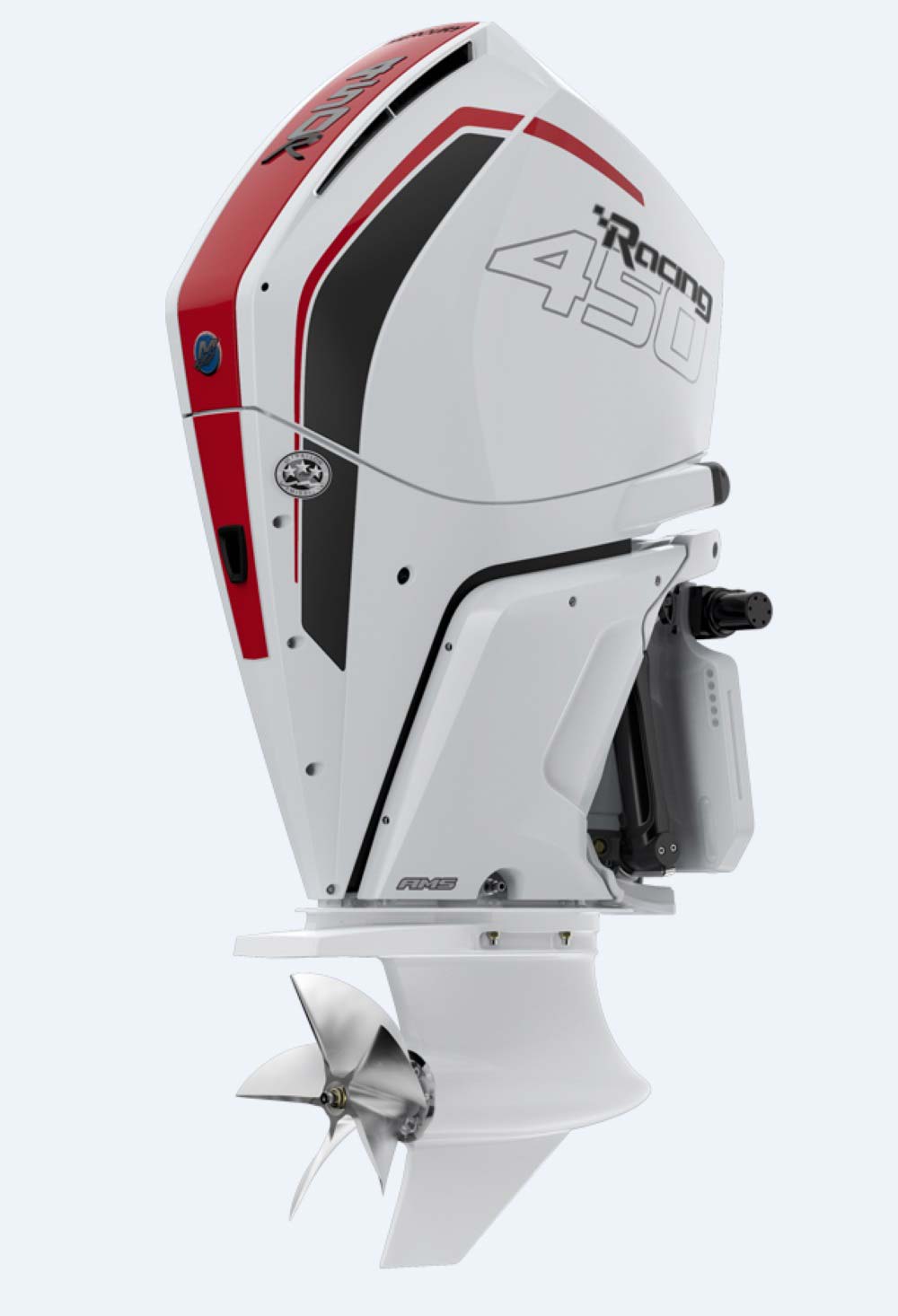 Not much is happening for the Brunswick team for 2021, but they have done enough over the past 18-months with the introduction of their new big block V6 and V8 to keep the production lines running full speed. The good news is that these new four-stroke outboards are in ready supply for both OEM/new engine and repower installations. I repowered my MarCeeJay, a 2006 EdgeWater 228 CC for the 2020 season with one of the new, lightweight 250HP V8s and the boat ran better than ever! Both performance (top speed, hole shots and cruising speeds) and fuel efficiency were improved, as was my ability to carry heavier loads. In retrospect, repowering with the Mercury 250 V8 FourStroke was one of the best moves that I’ve made with my EdgeWater.
Not much is happening for the Brunswick team for 2021, but they have done enough over the past 18-months with the introduction of their new big block V6 and V8 to keep the production lines running full speed. The good news is that these new four-stroke outboards are in ready supply for both OEM/new engine and repower installations. I repowered my MarCeeJay, a 2006 EdgeWater 228 CC for the 2020 season with one of the new, lightweight 250HP V8s and the boat ran better than ever! Both performance (top speed, hole shots and cruising speeds) and fuel efficiency were improved, as was my ability to carry heavier loads. In retrospect, repowering with the Mercury 250 V8 FourStroke was one of the best moves that I’ve made with my EdgeWater.
The 3.4L V6 and 4.6L V8 outboard engine models are available in five family configurations (FourStroke, Pro XS, Verado, Racing and SeaPro commercial). Most of these (the 450R is supercharged) are naturally aspirated and feature large displacement powerheads that have been designed to shed bulk and are incredibly lightweight. The XL versions of each engine weigh only 485 (V6) and 539 pounds (V8), so they should prove to be an excellent choice for boaters retrofitting older tired two-strokes with weight limitations on the transom. The V6 and V8 models offer class-leading displacement and a performance-inspired dual overhead cam design that delivers instant throttle response and immediate power. A single throttle body and long performance-tuned intake runners pack more air into the cylinders to boost torque. Yet another feature is Transient Spark Technology, which optimizes spark timing to produce more torque during hole shots. Advanced Range Optimization improves cruise-speed fuel efficiency by automatically adjusting fuel delivery so seamlessly, the operator won’t feel or hear it. Patented closed-loop fuel control uses a wide-range oxygen sensor to optimize the air-to-fuel ratio during all operating conditions. The unique Adaptive Speed Control allows these new Merc V6 and V8 outboards to maintain a desired rpm regardless of changes in load or conditions (such as rough water, tight turns, lower planning speeds, etc.). This translates to fewer adjustments to the throttle lever position – just set it and forget it. A convenient top cowl service door is another industry-exclusive and simplifies routine maintenance with easy oil checks and oil fills without removing the cowl. It also houses the latch release and a carrying handle just in case you need to take the cowl off the motor. Unlike some competitor’s high output four-strokes that require premium fuel to operate, the new Mercury V6 and V8 outboards deliver peak performance and reliability on less expensive 87-octane fuel.
Mercury’s top-of-the-lineup 400 Verado and 450R V8 are also noteworthy in that they both produce their power using 89-octane gasoline in platforms that weigh under 700 pounds, and are finding their way in clusters onto the transoms of a diverse group of 35 to 55-foot offshore sport fishers and go-fast craft. For more information, visit www.mercurymarine.com.
Yamaha
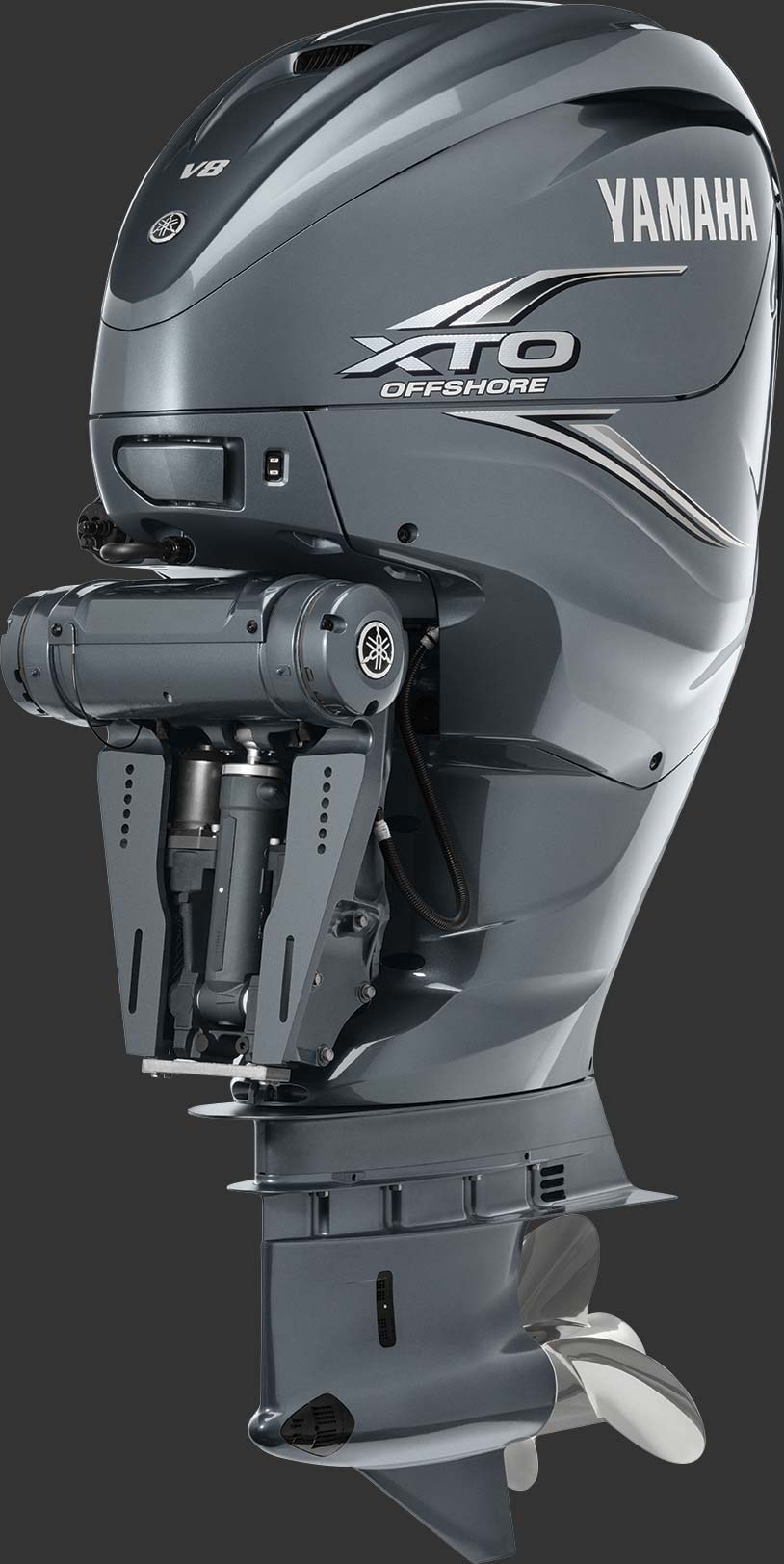 Yamaha continues to make big waves with its breakthrough 425 XTO Offshore V8 four stroke, which was introduced a few years back and is now readily available via dealers nationwide. This massive outboard was installed on dozens of 30 and 40-something sportfishers down at the 2020 Miami Boat Show back in February and its development is the result of years of Yamaha’s OEM collaboration with top boat manufacturers. It has been purpose-built from the ground up to provide the ultimate in power and efficiency offshore for large, ocean-going, bluewater fishing machines. It was one the first outboards to successfully challenge the market dominance of Seven Marine/Volvo’s mega 557 and 627 V8 outboards for supersized 40 to 55-foot sportfishers, with a product that was only a third of the cost of the now mothballed Seven Marine/Volvo four-stroke powerplants. The 425 XTO is available in three different shaft lengths (25, 30, 35-inches), plus two stock colors (dark gray and pearlescent white), and offers the ultimate in installation flexibility when mounted on large sport fishing boats in pairs, triples, quads or five-engine arrays.
Yamaha continues to make big waves with its breakthrough 425 XTO Offshore V8 four stroke, which was introduced a few years back and is now readily available via dealers nationwide. This massive outboard was installed on dozens of 30 and 40-something sportfishers down at the 2020 Miami Boat Show back in February and its development is the result of years of Yamaha’s OEM collaboration with top boat manufacturers. It has been purpose-built from the ground up to provide the ultimate in power and efficiency offshore for large, ocean-going, bluewater fishing machines. It was one the first outboards to successfully challenge the market dominance of Seven Marine/Volvo’s mega 557 and 627 V8 outboards for supersized 40 to 55-foot sportfishers, with a product that was only a third of the cost of the now mothballed Seven Marine/Volvo four-stroke powerplants. The 425 XTO is available in three different shaft lengths (25, 30, 35-inches), plus two stock colors (dark gray and pearlescent white), and offers the ultimate in installation flexibility when mounted on large sport fishing boats in pairs, triples, quads or five-engine arrays.
As the first four-stroke powerhead in the outboard industry to use direct injection, the V8 XTO Offshore sprays fuel at high pressure directly into the combustion chamber, rather than using an intake track/intake valve setup. This improves atomization and increases the effectiveness of the fuel burn for maximum power and efficiency. The direct injection system features five fuel pumps and injection pressure up to 2900 PSI to ensure proper fuel flow, even at high engine RPM. Yamaha’s V8 XTO Offshore also boasts the highest compression ratio in an outboard at 12.2:1. In addition to an oversized gearcase, hardened gears, a robust, offshore bracket and motor mounts, the Yamaha 425 V8 XTO Offshore outboard also features proven plasma fusion technology for durability and lighter weight, eliminating the usual steel cylinder sleeves. This outboard also has a two-stage water pump and dual chamber oil pump, each designed to respond to heavy loads and high RPM operation. Dual overhead camshafts on each cylinder bank are connected via a self-tensioning chain immersed in an oil bath for accurate valve timing and long life. The 425 XTO has an integrated electric steering system with no hydraulic lines or linkages, and responds more quickly than conventional systems to steering inputs. In addition, integrated electric steering translates to clean rigging and a very orderly bilge area. The new XTO Offshore outboard also features an integral electronic steering control unit that receives signals from the steering cylinder position sensor to carry out joystick and steering operation with an optional Helm Master. This beast is fuel by 89-octane gasoline, backed by a 5-year limited warranty. Yamaha has also introduced a new Helm Master EX for single engine applications. Although this won’t crab your boat sideways (you need two or more outboards to do that), there are numerous product benefits to this scalable system that offers joystick maneuverability and more that we will detail in a future Fisherman product review. For additional information, visit www.yamahaoutboards.com
Honda
A call into Honda revealed that there was nothing new for the beginning of 2021, but they are constantly working on improvements to their growing product line. Honda Marine’s latest offerings, the BF200, BF225 and BF250 four-stroke V6 outboards, all sport a new progressive V form design. This trio is now based on the same proven 3.6-liter V6 platform that powers the BF250 outboard motor. Improved corrosion resistance and decreased maintenance time add up to enhanced reliability and greater ease of use. All three of these V6 Honda outboard motors feature multiple rigging options for a customized on-the-water experience, with choices including both Intelligent Shift and Throttle (iSTR) and mechanical control options, newly designed user interfaces and a multi-function color display. The BF200-225-250 are now available in either Aquamarine Silver or Grand Prix White to better match the style and trim of your boat.
This trio of Honda V6s incorporates more than cosmetic appearance changes. Corrosion resistance has been improved with a new coating on the surface of engine hardware that utilizes a chemically treated, zinc-nickel plating with a high corrosion-resistant top coat. In addition, components including the oil pan, thermostat cover, upper mount cover, and prop shaft holder use a higher corrosion-resistant material, resulting in a more durable engine and gear case. And for more time on the water, routine maintenance time is reduced for activities such as oil and filter changes on the refreshed V6 outboards, courtesy of a larger diameter dipstick tube, the integration of a water separator and fuel strainer and relocation of the high-pressure filter (from the high-pressure pump) for easier access.
The technology applied to the refreshed Honda BF200, BF225 and BF250 V6 engines is derived from Honda automobiles, gaining from years of proven Honda engineering, precision manufacturing and reliability. This cross-platform integration of technology illustrates Honda’s commitment to high performance, fuel efficiency and environmental excellence. Innovative features like variable valve timing, programmed fuel injection, boosted low speed torque (BLAST) combined with a lean burn control give these V6s impressive performance and fuel economy. I sea trialed a few of these last year and was favorably impressed with the power and response of Honda’s new 3.6 liter V6 outboards. For more information, visit https://marine.honda.com
Tohatsu
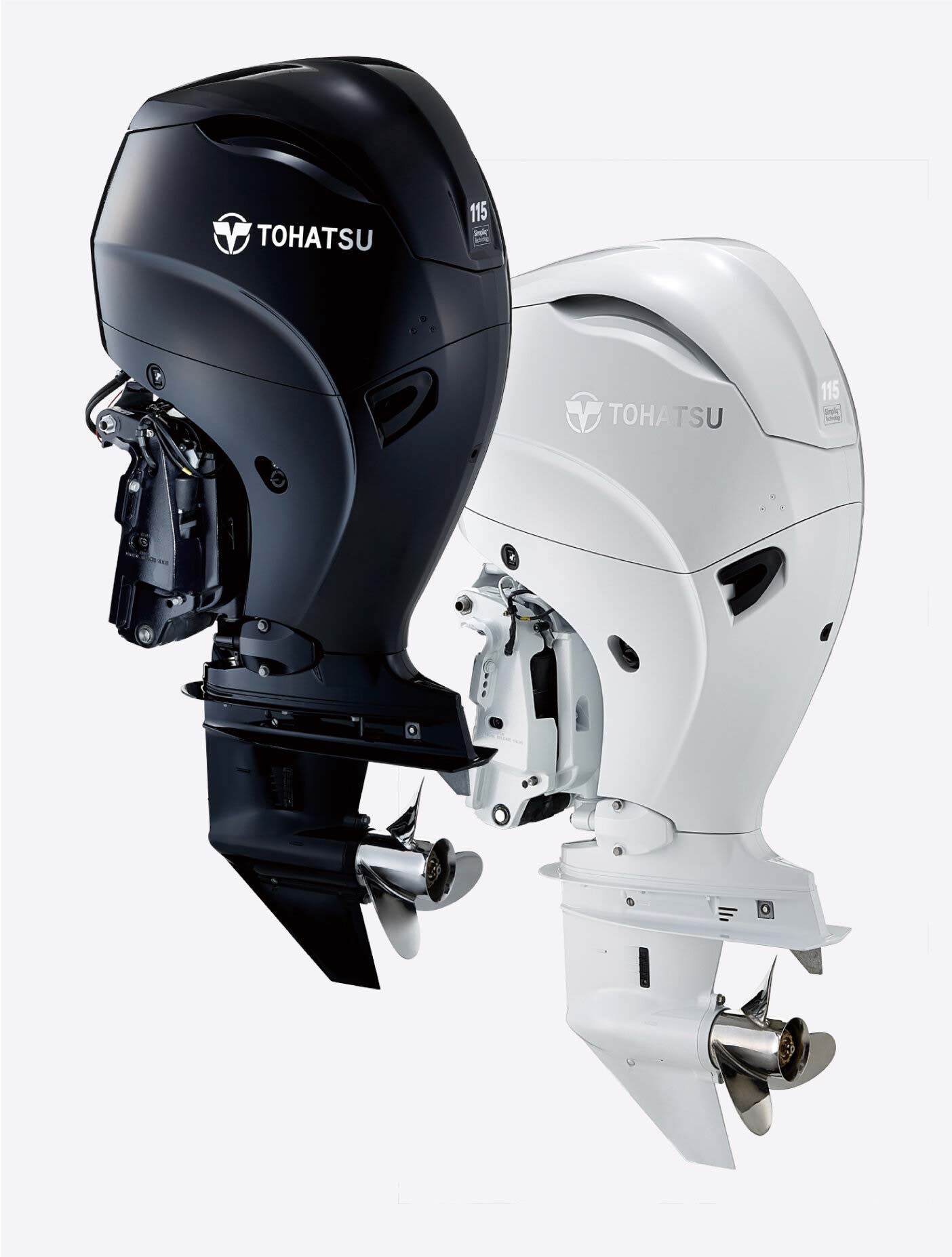 With the introduction of their new MFS 75-90-115A four stroke models for the 2021 model year, Tohatsu now designs and manufactures all of its portable and mid-range four-strokes from 2.5-to-115 HP in-house at its Japan-based facility. Their four high-power outboards (150-200-225-250) are actually made by Honda Marine and adorned with the Tohatsu decals, logos and color schemes.
With the introduction of their new MFS 75-90-115A four stroke models for the 2021 model year, Tohatsu now designs and manufactures all of its portable and mid-range four-strokes from 2.5-to-115 HP in-house at its Japan-based facility. Their four high-power outboards (150-200-225-250) are actually made by Honda Marine and adorned with the Tohatsu decals, logos and color schemes.
Tohatsu’s new MFS75/90/115A four stroke outboards are a natural evolution of their best-selling MFS40/50/60 models and essentially feature a super-scaled design in a larger footprint. The legacy of their top performing and most reliable engines has been passed on to these next-generation yearlings, which include a host of industry-first innovative features and characteristics. One of the most interesting of these new enhancements is the ground-breaking 4-2-1 Performance Tuned Exhaust, which provides steady torque throughout the RPM range. The more torque you have on take-off, the faster/better the hole shot, in addition to having a realistic “passing gear” when you hit the throttle during lower cruising speeds. In engineering terms, the “isometric aggregated exhaust manifold” 4-2-1 maximizes torque and acceleration performance. This unique design is an industry-first and currently is a Tohatsu exclusive. By engineering each exhaust passage to be equal in length, the merging of exhaust of each cylinder creates extra suction that helps pull the exhaust from the engine. This completely eliminates the possibility of exhaust interference and drastically improves the performance.
The synergy between the 4-2-1 Performance Tuned Exhaust and the ECU programming on the new 75/90/115A four-strokes provides strong acceleration when needed in order to get the boat on plane quicker and allowing the operator to reach top end speed faster. These new outboards feature a unique SOHC/four-valve design where the spark plugs are strategically placed in the center of the each combustion chamber for the most efficient combustion with optimal heat conduction, which results in strong running and fuel efficiency. Equipped with standard features such as the Variable Idle System; a micro-computer controlled ignition system for quick starts and instant throttle response; electronic fuel injection; a low gear ratio (2.08:1) that provides increased low end torque; a fresh-water flushing system designed to make routine flushing easier and a high output 41-amp alternator, the trio are a perfect match for small-to-midsized boats. Other notable features on the Tohatsu 75-90-115A four-strokes include a new gear case with wider splash and anti-ventilation plates; adjustable steering friction and trim tab for reduced steering effort; an oil tray catch pan set underneath the filter for cleaner oil changes; an easily accessible and removable fuel filter; and a stainless steel water pump housing for increased durability. All three are offered with an optional multi-function tiller handle with grip end PTT (power tilt and trim) switch and are backed by a five year limited warranty. For more info, visit www.tohatsu.com/marine/na.
Evinrude
On May 27, 2020, BRP announced that it had re-oriented its marine business by focusing on the growth of its boat brands with new technology and innovative marine products. According to a BRP press release, president Jose Boisjoli stated, “We will discontinue production of Evinrude E-TEC and E-TEC G2 outboard engines. Our Sturtevant, WI, facility will be repurposed for new projects to pursue our plan to provide consumers with an unparalleled experience on the water. We remain committed to our Buy, Build, Transform Marine strategy which has been underway since 2018 with the acquisition of Alumacraft and Manitou boat companies in the U.S., followed by the acquisition of Australian boat manufacturer Telwater in 2019.”
“Our outboard engines business has been greatly impacted by COVID-19, obliging us to discontinue production of our outboard motors immediately. This business segment had already been facing some challenges and the impact from the current context has forced our hand. We will concentrate our efforts on new and innovative technologies and on the development of our boat companies, where we continue to see a lot of potential to transform the on-water experience for consumers. Following our decision to discontinue E-TEC and E-TEC G2 outboard engines, we have signed an agreement with market leader Mercury Marine to support boat packages and continue to supply outboard engines to our boat brands. We will continue to supply customers and our dealer network service parts and will honor our manufacturer limited warranties, plus offer select programs to manage inventory. These decisions will impact 650 employees globally. With this announcement, BRP will be positioned to expand its presence in the pontoon and aluminum fishing markets through technologically advanced solutions. We will leverage our track record of ingenuity through our R&D resources to enhance the boating experience with unique new marine products, such as the next generation of engine technology with Project Ghost and the next generation of pontoons with Project M, code names for new products we expect to transform the industry.
Lastly, we will consolidate Alumacraft operations from two sites to one. All Alumacraft operations will be transferred to St Peter, MN and our site in Arkadelphia, AR will be permanently closed. In addition, we want to upgrade the boat production facilities to reorganize manufacturing sites and apply the modularity model used elsewhere. This move is designed to enhance productivity and efficiency and to allow us to respond with even more agility to demand.”

